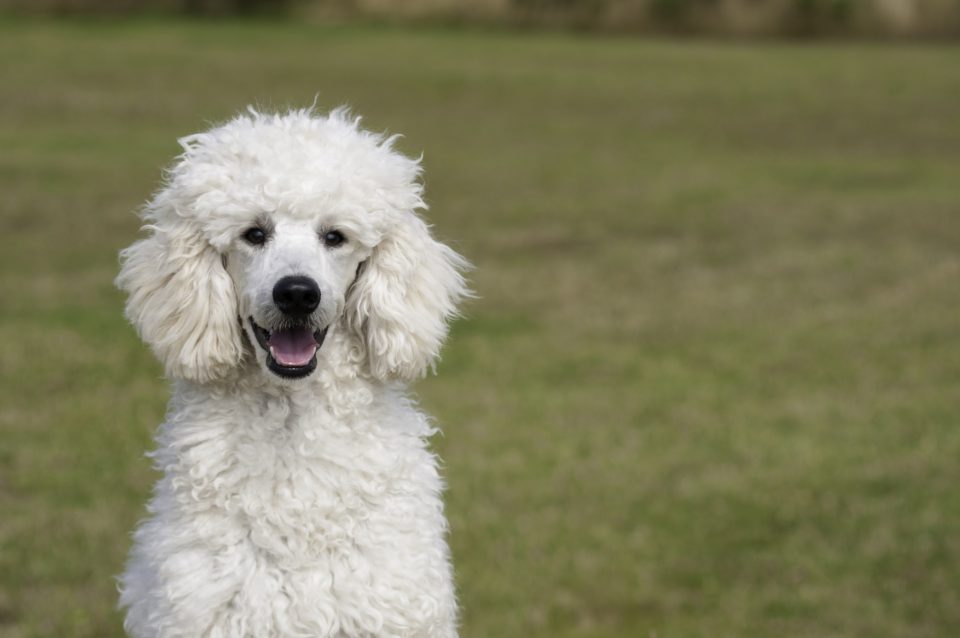Allergies are a common woe that many people face, whether they are food allergies, skin allergies, or environmental allergies—such as dog and cat allergies.
Bringing a dog into your home when you’re allergic to them is a delicate and daunting task. Luckily, there are many breeds that shed very little or not at all… which makes them perfect candidates for anyone with allergies.
My name is Michelle Ropp, and like many members of my family, I suffer from a long list of allergies. I count myself lucky that I’m not allergic to dogs, especially since I love them so much.
I am allergic to cats, though, so I’m all-too-familiar with the burning eyes, the struggle to breathe, and the dull ache and itch that permeates every inch of you from your face to your throat to your hands from being around an animal you’re allergic to—no matter how cute they are.
I’ve discovered that my reactions vary widely upon breed, and the same is true for dogs as well. If you suffer from an allergy to dogs and love them as much as I do, there’s good news.
There are many different types of beautiful, loving “hypoallergenic” dogs out there that will trigger your allergies far less than other breeds.
What Causes Dog Allergies?
Like with most allergies, dog allergies are triggered by an overreaction of the immune system to a (normally harmless) protein found in dog dander or dog saliva.
Allergies are often passed down from one family member to another, and though there are ways to decrease their effect with preventative measures or short-term treatments, they are a permanent condition.
Allergies can be a serious medical condition. Some allergies may be mild, and others may be life-threatening.
If you suspect you’re suffering from allergic reactions, you can make an appointment with an allergist to safely test for allergies.
This test will not only show what you’re allergic to, but it will also show the severity of your allergies. An allergist can also help you to take preventative steps to ensure you stay safe and suffer allergic reactions less often.
Are any Dogs Truly Hypoallergenic?
Hypoallergenic is a term that’s thrown around a lot these days. It’s boasted on special lotions, in certain foods, and in dog breeds. But what does it mean?
Sadly, there is no such thing as anything that is truly hypoallergenic. Because allergies vary so widely from individual to individual, something that is safe for one person may not be safe for another.
Proteins are found in all animals, including humans and dogs, and any one of them could be the specific trigger for an allergy.
And while proteins found in dander and saliva are the primary culprits with dogs, even hairless dogs still carry the proteins.
So What’s the Difference?
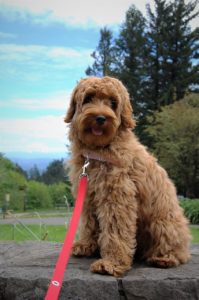 Well, although all dogs have dander and saliva, the type of hair they have and how much they shed determine how much of it you’ll be exposed to.
Well, although all dogs have dander and saliva, the type of hair they have and how much they shed determine how much of it you’ll be exposed to.
A husky in the heat of summer is much more likely to trigger a severe reaction as fur goes flying everywhere than a hairless dog with minimal impact on a house, furniture, and the air around it.
Hairless dogs aren’t the only “hypoallergenic” breeds, either.
Most dogs have two coats: one that they shed, and one that they do not.
Some dogs, however, have only the non-shedding coat, which means they rarely ever shed and, because of this, they affect people with allergies far less than their shedding counterparts.
Tips for Reducing Dog Allergy Symptoms
It’s wise to consult your doctor before getting a dog if you are allergic.
They, more than anyone, understand what you can do to minimize the impact of an animal on your allergies and help discuss breeds and options depending on the severity of your allergies.
Once you bring your new family member home, though, there are a few things you can do to help keep any allergic reactions to a minimum as well.
Preventative measures are the best ways to reduce allergy symptoms. This means making sure that your dog and your home stays as dander-free and saliva-free as possible.
Picking a “hypoallergenic” dog breed or hybrid is your first step. Next, you’ll want to make sure that they are groomed thoroughly and regularly.
Frequent baths and brushing will help prevent the build-up of dander. If you’re allergic, it’s best to leave this to someone who is not allergic—either a professional or another family member—for your safety and well-being.
It’s best to groom outside of the house (either at a groomer’s or out in the yard) to prevent extra exposure.
Regular vacuuming (including furniture) will also help a lot. You can check out the best vacuum cleaners for pet hair here!
Clean your carpet with allergen-neutralizing carpet shampoo, wash your dog’s bed often, and wash fabric in common areas frequently (such as couch pillowcases and curtains).
If your dog goes into your bedroom, wash your bedding very regularly. However, you may want to make your bedroom a no-dog zone to minimize the impact on your allergies.
This doesn’t mean your dog can’t have a comfy bed and nice warm place to sleep in the living room or another room, but keeping your dog out of your bedroom helps to ensure you breathe easy when you sleep.
Change your air filters frequently and use a high-efficiency HEPA air cleaner to help ensure allergies in the air stay at a minimum. We’ve covered some of the best air purifiers for pet hair here.
You might want to talk to your doctor about potentially taking a daytime allergy medication for everyday symptoms. These will not stop an allergy attack in its tracks. They will decrease the severity of symptoms, though.
Choosing the Right Hypoallergenic Dog for You
Whether it is dander or saliva that sets your allergies off, different breeds—even “hypoallergenic” ones—will affect you differently.
Allergies are unique from person to person. Because of this, it is important to spend plenty of time with any dog you are considering adding to your family to see how, or if, you react to them.
If you suffer a reaction to a dog in the short term, keep in mind that it will be a more severe reaction in the long-term.
Ideally, look for a dog that you do not notice any allergy symptoms with while you visit them, get to know them, and spend time with them before bringing them home.
Now that you know what to expect— what are some of the best “hypoallergenic” dog breeds to consider as you search for your new best friend?
12 Hypoallergenic Dog Breeds
1. Schnauzer
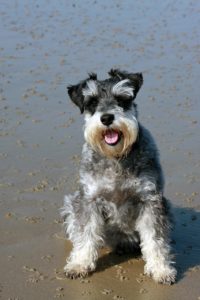 Originally bred in the 14th century to work on German farms, Schnauzers come in a range of sizes from Giant to Miniature and make great companions.
Originally bred in the 14th century to work on German farms, Schnauzers come in a range of sizes from Giant to Miniature and make great companions.
They are handsome, energetic, and great family dogs that are easy to groom.
Their wiry coats hardly ever shed, but be warned—Schnauzers have a sense of adventure and love to explore.
They are very active and are happiest when they can share their adventures with you.
2. Chinese Crested
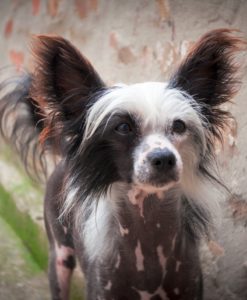 Originally bred to keep ships rat-free, Chinese Crested dogs have a striking look with their wild “hair-do” and sleek body.
Originally bred to keep ships rat-free, Chinese Crested dogs have a striking look with their wild “hair-do” and sleek body.
They are very allergy-friendly due to having almost no hair.
These tiny canines are full of attitude and not afraid to make themselves heard, but they are happiest snuggled up in a warm lap.
Chinese Crested dogs come in a hairless variety and a Powderpuff variety—both are equally cute, but the hairless variety will have an even smaller impact on allergies.
3. Portuguese Water Dog
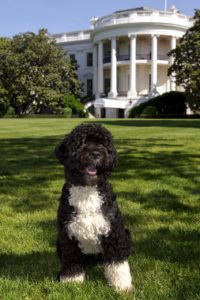 This breed drew a lot of attention after the world met Bo, the beloved Portuguese Water Dog that joined the Obamas in the White House in Barack Obama’s time as US President.
This breed drew a lot of attention after the world met Bo, the beloved Portuguese Water Dog that joined the Obamas in the White House in Barack Obama’s time as US President.
Working dogs by nature, Portuguese Water Dogs come in a variety of sizes and are great with kids.
They love to swim, as their name implies, and are cheerful, energetic, and highly affectionate dogs.
4. Bichon Frise
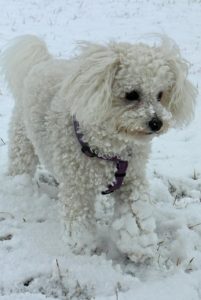 Famous for their soft, teddy-bear-like appearance, Bichon Frise have thick wooly coats with a “cotton ball” appearance that are virtually non-shedding and dander-free.
Famous for their soft, teddy-bear-like appearance, Bichon Frise have thick wooly coats with a “cotton ball” appearance that are virtually non-shedding and dander-free.
They are natural comedians full of personality. Bichon Frise love to play just as much as they love to snuggle, and they are wonderful with kids.
Smart and easy to train, the Bichon Frise makes an excellent companion for just about anyone.
Speaking of easy to train, if you’re looking for some fun tricks to teach your dogs, check out our article on Brain Training for Dogs here!
5. Poodles
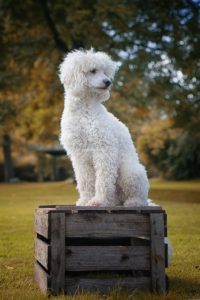 The Poodle is, perhaps, the most famous “hypoallergenic” dog.
The Poodle is, perhaps, the most famous “hypoallergenic” dog.
Many dogs have been crossed with poodles to create designer hybrids because of their non-shedding, allergy-friendly tendencies.
Instead of fur, Poodles are covered in curly hair which almost never sheds.
Poodles come in several sizes all the way from tiny Toy Poodles to large Standard Poodles.
They are incredibly intelligent (if sometimes stubborn) and are considered to be one of the most intelligent dog breeds.
Playful and social by nature, Poodles make wonderful family pets.
6. Yorkshire Terrier
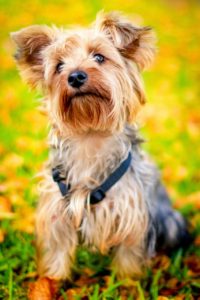 Yorkies are wildly popular and for good reason—they are great with kids, cute, compact (at just 4-7 pounds), and they sport hair instead of fur like the poodle, making them an excellent option for allergy-sufferers.
Yorkies are wildly popular and for good reason—they are great with kids, cute, compact (at just 4-7 pounds), and they sport hair instead of fur like the poodle, making them an excellent option for allergy-sufferers.
These pint-sized pups were first bred by migrants from Scotland to hunt rats in mines, and trace their ancestry back to Scottish, Clydesdale, and Skye terriers.
They were quick to catch the attention of nobles and in time they shifted from hard-working rat-chasers to pampered lapdogs.
Yorkies come in a variety of different coat-types including long, fluffy, or short hair. Despite this, their coat doesn’t require a lot of upkeep.
7. Afghan Hound
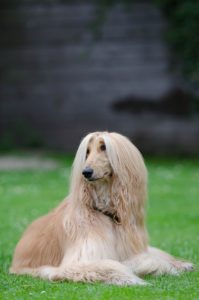 At first glance, the Afghan Hound looks anything but hypoallergenic. In incredible contrast to short or hairless varieties on this list, Afghan Hounds have long, sweeping coats that lend them an ethereal, elegant appearance.
At first glance, the Afghan Hound looks anything but hypoallergenic. In incredible contrast to short or hairless varieties on this list, Afghan Hounds have long, sweeping coats that lend them an ethereal, elegant appearance.
The coat of these sight-hounds was originally intended to protect them from the harsh mountain climate that they originally called home, and despite its impressive length, their coat rarely ever sheds.
Afghan Hounds are high maintenance when it comes to grooming because of their flowing coats and they can be stubborn, but these hounds are unwaveringly faithful, good with kids and other pets, and have a charm and sophistication all their own.
8. Havanese
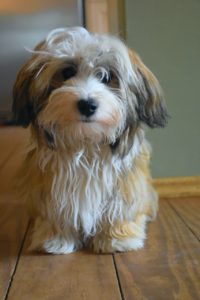 Native to Cuba, Havanese dogs are excellent family dogs that hardly shed at all. They are affectionate, curious, and very friendly.
Native to Cuba, Havanese dogs are excellent family dogs that hardly shed at all. They are affectionate, curious, and very friendly.
Havanese love to meet new people, play, and go on adventures. These clever dogs are easy to train and love to learn tricks.
With coats thicker than Bichon Frise, these toy-sized pups have a plush, soft coat that helps to protect them from the sun and is perfect for petting.
9. Labradoodle
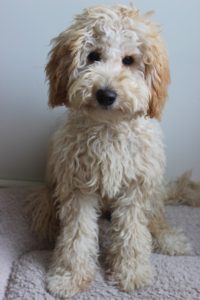 Designer hybrids that have earned a lot of love, Labradoodles were originally bred from Labrador Retrievers and Poodles to be a hypoallergenic guide dog.
Designer hybrids that have earned a lot of love, Labradoodles were originally bred from Labrador Retrievers and Poodles to be a hypoallergenic guide dog.
They shed less than the average dog and are smart and friendly by nature.
Because they are hybrids, Labradoodles vary in temperament, how much they shed, and many other factors.
It’s best to spend plenty of time beforehand with the dog you are considering (this is important regardless of breed if you have dog allergies) to ensure that they don’t put too much of a strain on your allergies.
10. Shih Tzu
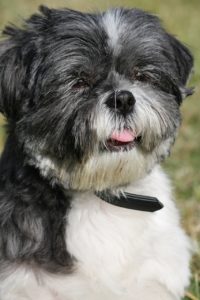 With a name that means “lion dog” in Chinese and a long history of being lapdogs to nobles and powerful people, Shih Tzus are a breed that dates all the way back to the Ming Dynasty.
With a name that means “lion dog” in Chinese and a long history of being lapdogs to nobles and powerful people, Shih Tzus are a breed that dates all the way back to the Ming Dynasty.
Their appearance is equally regal, with a long coat that rarely sheds.
Shih Tzus are the perfect size for small homes or apartments at only 9-16 lbs, and they come in almost any color.
Affectionate and loyal by nature, Shih Tzus are easy to train and always alert.
Although they do demand extra attention when it comes to grooming, Shih Tzus are playful and sweet and loves to make friends which make them excellent companions.
11. Airedale Terrier
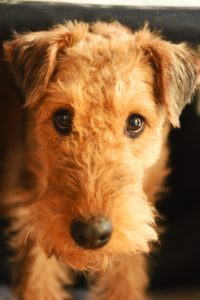 The Airedale Terrier is the largest of all the terriers and has an equally big love of adventure and play.
The Airedale Terrier is the largest of all the terriers and has an equally big love of adventure and play.
They are clever, confident, and easy to train, and they shed less than average — especially when brushed regularly.
To satisfy an Airedale Terrier’s sense of adventure, they will need lots of exercise and play.
They are excellent with kids and other pets, though, which can help provide some of the stimulation they crave.
12. Scottish Terrier
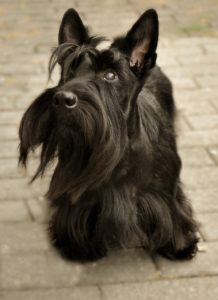 Scottish Terriers, or Scotties for short, are handsome, fun-loving dogs that shed very little and have a larger-than-life sense of adventure.
Scottish Terriers, or Scotties for short, are handsome, fun-loving dogs that shed very little and have a larger-than-life sense of adventure.
Be careful leaving a Scottie outside, though — their search for adventure often leads them to mischief as they entertain themselves with digging, chasing squirrels, and exploring.
These protective pups make wonderful watchdogs but do best with thorough obedience training to make sure they are well-behaved.
Scotties need extra grooming to keep their coat in good order, so it’s important to take them to a groomer frequently in order to keep you, and them, happy and healthy.
Final Thoughts
Any of these dog breeds would make wonderful companions—and they are all gentler on allergies, too.
If you are looking for even more “hypoallergenic” dogs in pint-sized proportions be sure to check out The Best Non-Shedding Small Dogs for even more options.
If you have any comments or questions, please feel free to leave them below!
